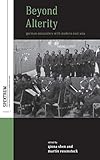Beyond Alterity : German Encounters with Modern East Asia / ed. by Martin Rosenstock, Qinna Shen.
Material type: TextSeries: Spektrum: Publications of the German Studies Association ; 7Publisher: New York ; Oxford : Berghahn Books, [2014]Copyright date: ©2014Description: 1 online resource (316 p.)Content type:
TextSeries: Spektrum: Publications of the German Studies Association ; 7Publisher: New York ; Oxford : Berghahn Books, [2014]Copyright date: ©2014Description: 1 online resource (316 p.)Content type: - 9781782383604
- 9781782383611
- 303.48/24305 23/eng
- DD120.J3 B48 2014
- DD120.J3
- online - DeGruyter
| Item type | Current library | Call number | URL | Status | Notes | Barcode | |
|---|---|---|---|---|---|---|---|
 eBook
eBook
|
Biblioteca "Angelicum" Pont. Univ. S.Tommaso d'Aquino Nuvola online | online - DeGruyter (Browse shelf(Opens below)) | Online access | Not for loan (Accesso limitato) | Accesso per gli utenti autorizzati / Access for authorized users | (dgr)9781782383611 |
Frontmatter -- CONTENTS -- ILLUSTRATIONS -- ACKNOWLEDGMENTS -- Introduction. Re-investigating a Transnational Connection: Asian German Studies in the New Millennium -- Part I. Japan and Germany in the Shadow of National Socialism -- Chapter 1. Beauty and the Beast: Japan in Interwar German Newsreels -- Chapter 2. Reflecting Chiral Modernities: The Function of Genre in Arnold Fanck’s Transnational Bergfilm, The Samurai’s Daughter (1936–37) -- Chapter 3. Prussians of the East: The 1944 Deutsch-Japanische Gesellschaft’s Essay Contest and the Transcultural Romantic -- Part II. From 1920s Leftist Collaboration to Global Capitalism -- Chapter 4. Otherness in Solidarity: Collaboration between Chinese and German Left-Wing Activists in the Weimar Republic -- Chapter 5. A Question of Ideology and Realpolitik: DEFA’s Cold War Documentaries on China -- Chapter 6. China Past, China Present: Th e Boxer Rebellion in Gerhard Seyfried’s Yellow Wind (2008) -- Part III. Negotiating Identity in Multicultural Germany -- Chapter 7. Anna May Wong and Weimar Cinema: Orientalism in Postcolonial Germany -- Chapter 8. Rewriting the Face, Transforming the Skin, and Performing the Body as Text: Palimpsestuous Intertexts in Yōko Tawada’s “The Bath” -- Chapter 9. Love, Pain, and the Whole Japan Thing: Dancing MA in Doris Dörrie’s Film Cherry Blossoms/Hanami -- Part IV. Trade, Travel, and Ethnographical Narratives -- Chapter 10. Hairnet Manufacturing in Vysočina and Shandong 1890–1939: An Early Globalizing Home Industry -- Chapter 11. Orbiting around the Void: Emptiness as Recurring Topos in Recent German Short Stories on Japan -- Chapter 12. Discovering Asia in the Footsteps of Portuguese Explorers: East Asia in the Work of Hugo Loetscher -- Notes on Contributors -- BIBLIOGRAPHY -- INDEX
restricted access online access with authorization star
http://purl.org/coar/access_right/c_16ec
With the economic and political rise of East Asia in the second half of the twentieth century, many Western countries have re-evaluated their links to their Eastern counterparts. Thus, in recent years, Asian German Studies has emerged as a promising branch within interdisciplinary German Studies. This collection of essays examines German-language cultural production pertaining to modern China and Japan, and explicitly challenges orientalist notions by proposing a conception of East and West not as opposites, but as complementary elements of global culture, thereby urging a move beyond national paradigms in cultural studies. Essays focus on the mid-century German-Japanese alliance, Chinese-German Leftist collaborations, global capitalism, travel, identity, and cultural hybridity. The authors include historians and scholars of film and literature, and employ a wide array of approaches from postcolonial, globalization, media, and gender studies. The collection sheds new light on a complex and ambivalentset of international relationships, while also testifying to the potential of Asian German Studies.
Mode of access: Internet via World Wide Web.
In English.
Description based on online resource; title from PDF title page (publisher's Web site, viewed 25. Jun 2024)


